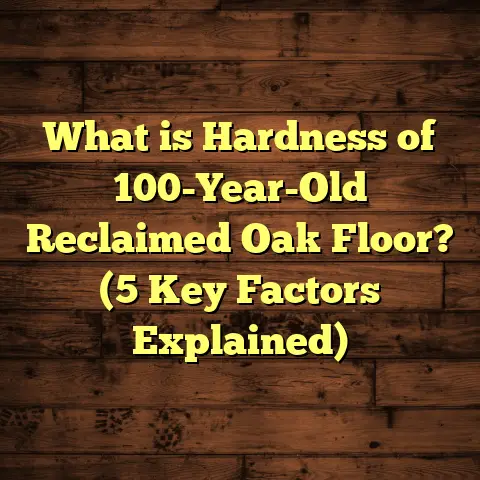What is Under Floor Heating? (5 Benefits You Didn’t Know!)
Imagine stepping into a chilly room on a cold morning, where the floor feels like a block of ice beneath your feet. Now imagine that same floor gently warming you from below, like a soft, comforting blanket that wraps you in coziness. That’s the magic of underfloor heating. It’s a technology that’s quietly transforming how we think about warmth and comfort at home.
Over the years, I’ve installed countless underfloor heating systems and lived with them myself, and I can tell you—it’s not just about warmer floors. It’s about changing the entire experience of being indoors during colder months. If you’re curious about what underfloor heating really is and why it might be the best upgrade for your house, let me walk you through everything I’ve learned, including some surprising benefits you probably haven’t heard before.
What is Underfloor Heating?
Underfloor heating (UFH) is exactly what it sounds like: a heating system installed underneath your floor surface that radiates warmth upwards. Instead of relying on radiators blasting hot air or vents pushing heated air around, underfloor heating delivers gentle, consistent heat across the entire floor area.
Types of Underfloor Heating
There are two main types of UFH systems:
1. Electric Underfloor Heating
This system uses thin electric cables or mats embedded beneath your floor covering. When powered on, these cables heat up and radiate warmth to the floor surface above. Electric UFH is popular for smaller spaces or renovations because it’s relatively quick and easy to install. It works especially well in bathrooms or kitchens where tile floors are common.
2. Hydronic (Water-Based) Underfloor Heating
Hydronic systems circulate warm water through a network of pipes laid beneath the floor. The water is heated by a boiler, heat pump, or solar thermal system and delivers efficient heat over larger areas or whole homes. Hydronic UFH usually requires more upfront work to install but offers lower running costs and greater energy efficiency over time.
How Does Underfloor Heating Work?
Both systems work on the principle of radiant heat — warm surfaces heat objects and people directly rather than heating air that can escape or stratify near ceilings. This means the warmth spreads evenly from the floor up, creating a more comfortable environment without cold spots or drafts typical of conventional heating methods.
Installation Basics
For electric UFH, the cables or mats are laid on top of a subfloor or insulation board, then covered with a screed or tile adhesive before installing the final floor finish. Hydronic systems require piping to be embedded in a concrete slab or fixed to insulation boards before laying the floor surface.
Proper insulation below the heating elements is critical for energy efficiency—without it, much of the heat escapes downward instead of warming your living space.
My First Experience with UFH
I remember my first job installing an electric underfloor heating system in a small bathroom renovation. The homeowner was skeptical at first, worried about costs and whether it would really feel warm enough. After installation, she sent me a message saying how she loved stepping out of the shower onto warm tiles instead of cold ones—it was a simple upgrade that made a big difference in daily comfort.
That initial positive feedback sparked my interest in exploring hydronic systems too. I wanted to see if they could offer similar comfort but on a bigger scale with better energy savings.
Comparing Underfloor Heating Options — Lessons from My Projects
Over the years, I’ve worked on dozens of projects involving both electric and hydronic UFH systems. Each has its strengths and weaknesses depending on the context.
Electric UFH: Quick and Flexible
Electric systems are great for tight timelines and smaller areas like bathrooms, kitchens, or conservatories where quick heat-up times are beneficial. Because electric mats are thin (about 3-5mm), they don’t raise floor height much — perfect for renovations where door heights and skirting boards are fixed.
That said, electric systems tend to have higher operating costs compared to hydronic setups because electricity prices are generally more expensive than gas or other fuels used for water heating.
Hydronic UFH: Efficient for Whole Homes
Hydronic systems shine when installed during new builds or major renovations where floors can be designed to accommodate them easily. They integrate well with renewable energy sources like solar thermal panels or heat pumps, making them future-proof and eco-friendly.
Installing hydronic UFH usually involves embedding pipes in concrete slabs, which adds thermal mass that retains heat longer—so rooms stay warm even after the system turns off.
Cost Comparison
From my experience and research:
- Electric UFH installation costs range roughly from $8 to $15 per square foot depending on system quality and complexity.
- Hydronic UFH installation costs are higher—typically between $10 to $25 per square foot—but operating costs can be 20-40% lower over time due to energy efficiency.
One client of mine had a 1,800 square foot house retrofitted with hydronic UFH connected to an efficient condensing boiler. The upfront cost was about $30,000, but their annual heating bill dropped by $1,200 compared to their previous system—paying off in about 7-8 years.
Energy Sources and Environmental Impact
Hydronic systems can run on various heat sources—natural gas boilers, electric boilers powered by renewable energy, heat pumps, or solar thermal water heaters—offering flexibility depending on your location and energy goals.
Electric UFH is generally limited to grid electricity, which may come from fossil fuels unless you have solar panels or another renewable source onsite.
5 Benefits You Didn’t Know About Underfloor Heating
Most people think underfloor heating is just about warm floors—but there’s so much more going on beneath your feet. Here are five benefits that surprised me during my projects and personal experience:
1. Even Heat Distribution Improves Overall Comfort
Radiators blast hot air from one spot—leaving cold corners behind and creating uneven temperatures. Underfloor heating spreads warmth evenly across every inch of the room floor area.
This uniformity reduces drafts and temperature fluctuations throughout the day. Instead of feeling hot near a radiator but chilly elsewhere, you get steady cozy warmth everywhere.
Personally, I noticed this effect staying overnight in houses with UFH installed; no matter where I sat or slept in the room, it felt equally warm and comfortable—a real game changer for winter comfort.
2. Better Indoor Air Quality for Allergy Sufferers
Forced-air systems circulate dust, pollen, and allergens through the house, which can aggravate asthma or allergies. Underfloor heating doesn’t rely on blowing air around; it gently radiates heat without stirring up dust particles.
A European Heating Industry study reported homes with radiant floor heating had significantly lower dust mite allergen levels compared to homes using traditional forced-air heating.
One family I worked with had an asthmatic child who experienced fewer symptoms after switching to UFH combined with improved air sealing—proving this benefit firsthand.
3. Energy Efficiency Means Lower Bills
Because UFH heats rooms evenly and maintains steady temperatures at lower thermostat settings, it uses less energy overall.
Hydronic systems especially benefit from water’s high heat capacity—it holds heat longer than air—meaning less frequent cycling of boilers or pumps.
According to the U.S. Department of Energy, underfloor heating can reduce total heating energy consumption by 10-30% compared to traditional radiator-based systems when properly installed with good insulation.
I had one client reduce their winter heating costs by $400 annually after switching to hydronic UFH paired with a smart thermostat that optimized heating schedules based on occupancy patterns.
4. Space-Saving Design Frees Up Walls
Radiators take up wall space that could be used for furniture or storage. With underfloor heating hidden beneath your floor surface, walls stay clean and open—giving you more freedom to decorate or arrange rooms as you please.
In one renovation project, removing bulky radiators allowed us to add built-in shelving along walls without compromising heating comfort—a win-win for design and function.
5. Works With Many Floor Types—Even Hardwood
A common question I get is whether underfloor heating will damage hardwood floors. The answer depends on correct installation and using engineered wood designed for use with radiant heat.
Materials like tile and stone conduct heat very well, making them ideal partners for UFH systems. Laminate and vinyl work too but require specific heat limits to avoid damage.
I’ve installed underfloor heating beneath oak hardwood floors multiple times without issues after following manufacturer guidelines for moisture barriers and maximum surface temperatures (usually below 27°C/80°F).
This flexibility means you don’t have to compromise your style—you get warm floors plus your preferred flooring material.
Personal Stories That Bring It All Together
Let me share some real-world stories from my projects that highlight these benefits:
Story 1: A Bathroom Transformation
A couple renovating their master bath wanted warm floors but were worried about cost and complexity. We went with electric underfloor heating mats beneath large porcelain tiles.
The wife told me later that simply stepping out of the shower onto heated tiles was one of her favorite parts of the new bathroom—it made mornings so much more pleasant during winter months.
Story 2: Whole-House Upgrade in a Cold Climate
In Maine, I worked with a family replacing old cast iron radiators in their 2,500-square-foot home with hydronic underfloor heating connected to a high-efficiency boiler and solar thermal system.
Their winter energy bills dropped by nearly 30%, but more importantly, they reported no cold spots anywhere in the house—even upstairs bedrooms stayed cozy without additional heaters.
The mother also mentioned how their asthmatic son’s symptoms improved thanks to reduced dust circulation from traditional forced-air systems.
Story 3: Historic Home Renovation Challenges
A historic house owner wanted modern comfort without ruining original wood flooring or aesthetics. We installed hydronic pipes beneath engineered hardwood flooring designed for radiant heat use.
The challenge was ensuring minimal floor height increase so existing door frames wouldn’t need modification. Careful planning made it work beautifully—warm floors all winter without losing character or charm.
Technical Insights: What Makes Underfloor Heating Efficient?
Understanding why underfloor heating performs so well requires some technical background:
- Radiant Heat Transfer: Unlike convection (air movement), radiant heat warms objects directly—including people—which feels more natural.
- Thermal Mass: Concrete slabs or screeds absorb heat from hydronic pipes and slowly release it over time—this “thermal inertia” keeps rooms warm longer.
- Low Water Temperatures: Hydronic systems operate efficiently at water temperatures between 30-50°C (86-122°F), compared to radiators needing 60-80°C (140-176°F), reducing energy consumption.
- Zoning Capability: Modern UFH setups allow precise control over different rooms (zones), so you only heat occupied spaces—saving energy.
- Insulation: Properly installed insulation beneath pipes/cables prevents downward heat loss—critical for maximizing efficiency.
Installation Tips from My Toolbox
If you’re considering installing underfloor heating yourself or hiring pros, here are some tips I’ve gathered over time:
- Plan Early: Especially for hydronic systems in new builds—coordinate plumbing and electrical work carefully.
- Choose Flooring Wisely: Tiles conduct heat well; wood needs careful matching to avoid warping.
- Don’t Skip Insulation: It might seem costly upfront but saves money long term.
- Use Quality Controls: Thermostats with sensors ensure floors don’t overheat.
- Test Before Covering: Verify electrical resistance (electric systems) or pressure tests (hydronic) before final floor installation.
- Hire Experienced Installers: Mistakes can be costly and tricky to fix once floors go down.
Common Questions About Underfloor Heating
Is underfloor heating expensive?
Initial installation can be pricier than traditional heating but lower operating costs often offset this over time—especially with hydronic systems combined with efficient boilers or renewables.
Can I install UFH myself?
Basic electric mats might be DIY-friendly if you’re handy but hydronic systems require professional plumbing expertise for safe operation and warranty compliance.
Will UFH dry out my indoor air?
No—it actually helps maintain balanced humidity levels better than forced-air heaters that can dry out rooms significantly.
How long does UFH last?
With proper installation and care, electric cables last 20+ years; hydronic pipes often last even longer since they’re made from durable materials like cross-linked polyethylene (PEX).
Can I install UFH under carpet?
Yes, but use low tog rating carpets (ideally below 1.5) to allow heat transfer without trapping it underneath.
Final Thoughts From My Experience
Underfloor heating is more than just a luxury—it’s an investment in comfort, health, design flexibility, and energy savings. From small bathroom upgrades to whole-house hydronic systems powered by renewables, UFH has proven itself repeatedly in my projects as one of the best ways to improve living environments during colder months.
If you’re curious about adding warmth beneath your feet or want advice tailored to your home’s unique needs, just reach out—I’d love to share more insights based on real-world results!





